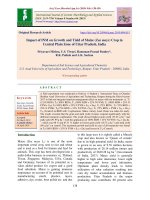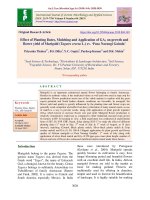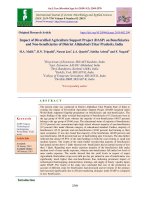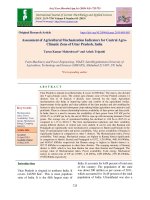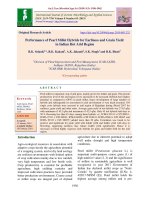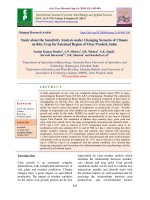Performance of tuberose varieties for flowering and flower yield parameters under Indo-gangetic plains of Eastern Uttar Pradesh, India
Bạn đang xem bản rút gọn của tài liệu. Xem và tải ngay bản đầy đủ của tài liệu tại đây (112.68 KB, 5 trang )
Int.J.Curr.Microbiol.App.Sci (2018) 7(8): 1129-1133
International Journal of Current Microbiology and Applied Sciences
ISSN: 2319-7706 Volume 7 Number 08 (2018)
Journal homepage:
Original Research Article
/>
Performance of Tuberose Varieties for Flowering and Flower Yield
Parameters under Indo-gangetic Plains of Eastern Uttar Pradesh, India
Ashish Singh*, Anil K. Singh, Anjana Sisodia and Minakshi Padhi
Department of Horticulture, Institute of Agricultural Sciences
Banaras Hindu University, Varanasi, U.P., India
*Corresponding author
ABSTRACT
Keywords
Tuberose, Variety,
Flowering, Yield
Article Info
Accepted:
08 July 2018
Available Online:
10 August 2018
An investigation on evaluation of tuberose (Polianthes tuberosa L.) was conducted
during2017-2018 at Horticulture Research Farm, Department of Horticulture, Banaras
Hindu University, Varanasi. In this experiment 14 tuberose varieties were evaluated. The
experiment was laid out in Randomized Block Design with three replications. The results
of experiment was revealed that the earliest spike emergence was recorded in variety Pune
Local Single. The variety Pune Local Single was reported earliest flowering whereas, late
flowering was recorded in ACC NO-9. Variety Arka Nirantara was recorded maximum
length of spike while minimum length of spike was recorded in variety ACC NO7.Cultivar ACC NO-9 was recorded maximum rachis length and minimum rachis length
was recorded in cultivar Mexican Single. Cultivar Phule Rajani was recorded maximum
number of florets per spike and minimum number of florets per spike was recorded in
cultivar Mexican Single. Maximum length of floret was reported in variety Prajwaland
minimum length of floret was recorded in variety ACC NO-7.Maximum diameter of floret
was recorded in variety Prajwal. Whereas, the minimum diameter of floret was recorded in
variety Mexican Single. Minimum inter nodal length was recorded in variety ACC NO-7
and maximum inter nodal length was recorded in variety Calcutta Double. Variety Calcutta
Single was recorded maximum duration of flowering while minimum duration of
flowering was found in variety ACC NO-7. Cultivar Prajwal was recorded maximum
number of spikes per plant while cv. ACC NO-7 was reported minimum number of spikes
per plant.
Introduction
The flower of tuberose is liked for its
prettiness, elegance and fragrance. Among the
ornamental bulbous plant tuberose occupies
important place. Tuberose was spread from
Mexico to the different countries during 16th
century (Singh and Sisodia, 2017). Tuberose is
commercially grown for cut flower, loose
flower as well as perfume industries. The
flowers of tuberose used for floral ornamental,
decoration, bouquets and in garlands.
Tuberose is also preferred for table decoration
in bowl and vase because its spike remains
fresh for long time (Singh, 2006). Tuberose is
hardy, perennial bulbous plant with fibrous
1129
Int.J.Curr.Microbiol.App.Sci (2018) 7(8): 1129-1133
root and perpetuating itself through bulblets.
The leaves are long, narrow and grass like
foliage with light green colour. The flowers
are waxy, white coloured and funnel shaped. It
has six stamen and three locular ovary and
fruits are capsule. Tuberose occupied
important position in local as well as global
markets. Evaluation of tuberose varieties for a
region to get commercial yield. The aim of the
experiment is to find the suitable cultivars to
this climatic condition and to improve the
economic condition of farmer.
Materials and Methods
The present investigation on evaluation of 14
tuberose varieties viz., Shringar, Calcutta
Double, Vaibhav, GKTC-4, Sikkim Selection,
Prajwal, Hyderabad Single, PhuleRajani, ACC
NO-9, Pune Local Single, ArkaNirantara,
ACC NO-7, Calcutta Single and Mexican
Single was laid out at Horticulture Research
Farm, Department of Horticulture, Banaras
Hindu University, Varanasi during 2017 to
2018.The bulbs were planted at 30 × 20 cm
apart at 8 cm depth. The uniform intercultural
operations were adopted for all varieties and
replications throughout the experiment. The
experiment was carried out in Randomized
Block Design with three replications. The
observations were recorded on different
flowering parameters viz., days to spike
emergence, days to flowering, length of spike,
rachis length, number of florets per spike,
length of floret, diameter of floret, inter nodal
length, duration of flowering and number of
spikes per plant. The observations were taken
from five selected plants from each
replication.
Results and Discussion
Varieties of tuberose responded significantly
for various flowering parameters (Table 1 and
2). Cultivar Pune Local Single was reported
earliest spike emergence which was
statistically at par with caves. Sikkim
Selection (43.93 days), Calcutta Single (51.60
days), Calcutta Double (51.60 days), Vaibhav
(52.40 days) and Mexican Single (53.47 days).
Late spike emergence was recorded in
germplasm ACC NO-9 (80.93 days).
The varietal difference in spike emergence
was also reported by Chaturvedi et al., (2014)
and Ramachandru and Thangam (2009).
Cultivar Pune Local Single was recorded
earliest flowering (56.47 days) which was
statistically at par with cvs. Sikkim Selection
(57.07 days), Mexican Single (67.53 days) and
Calcutta Single (68.33 days). Late flowering
was recorded in germplasm ACC NO-9 (94.20
days). Difference in days to flowering was
also reported by Singh et al., (2013) and
Krishnamoorthy (2014). Cultivar Arka
Nirantara was recorded maximum length of
spike (98.48 cm) and significant with cvs.
ACC NO-9 and Prajwal. Whereas, the
minimum length of spike was recorded with
ACC NO-7.
The variation in length of spike as affected by
different varieties was also noticed by Patil et
al., (2009) and Chaturvedi et al., (2014).
Germplasm ACC NO-9 was reported
maximum rachis length (34.01 cm) which was
statistically at par with cv. Vaibhav (32.75
cm) and minimum rachis length was recorded
in variety Mexican Single (10.59 cm). The
varietal difference in rachis length was also
reported by Prakash et al., (2015) and Rao and
Sushma (2015). Maximum number of florets
per spike (44.87) was recorded in cv. Phule
Rajani which was statistically at par with Pune
Local Single (41.67) and GKTC-4 (40.13).
Variation in various flowering parameters in
different varieties was due to genetic make of
germplasm. The minimum number of florets
per spike was found in cultivar Mexican
Single (20.07). The variation in number of
florets per spike was also noticed by Ranchana
et al., (2015) and Vijayalaxmi and
Lakshmidevamma (2016).
1130
Int.J.Curr.Microbiol.App.Sci (2018) 7(8): 1129-1133
Table.1 Evaluation of tuberose varieties for flowering characters
Treatment
Shringar
Calcutta Doubl
Vaibhav
GKTC-4
Sikkim Selection
Prajwal
Hyderabad Single
PhuleRajani
ACC NO-9
Pune Local Single
ArkaNirantara
ACC NO-7
Calcutta Single
Mexican Single
C.D. at 5%
Days to spike
emergence
71.27
51.60
52.40
61.93
43.93
72.40
69.20
65.07
80.93
41.20
60.80
70.40
51.60
53.47
12.61
Days to
flowering
81.20
76.20
78.67
76.53
57.07
85.47
80.80
77.27
94.20
56.47
75.15
80.53
68.33
67.53
12.28
Length of
spike (cm)
67.67
78.46
73.89
69.79
55.30
83.87
67.61
62.44
84.99
63.19
98.48
41.71
71.94
56.34
6.21
Rachis length
(cm)
25.24
27.74
32.75
24.62
16.68
24.73
25.74
22.39
34.01
18.92
20.51
14.13
23.15
10.59
5.59
No. of
florets/spike
37.73
27.40
37.73
40.13
23.67
34.13
36.07
44.87
36.00
41.67
22.95
36.73
35.47
20.07
6.25
Table.2 Performance of tuberose varieties for flowering parameters
Treatment
Shringar
Calcutta Double
Vaibhav
GKTC-4
Sikkim Selection
Prajwal
Hyderabad Single
PhuleRajani
ACC NO-9
Pune Local Single
ArkaNirantara
ACC NO-7
Calcutta Single
Mexican Single
C.D. at 5%
Length of
floret (cm)
4.50
4.39
5.52
4.41
5.04
5.65
4.94
5.41
4.74
4.70
4.75
3.60
4.71
4.58
0.31
Diameter
of floret
(cm)
3.65
4.40
4.22
3.67
3.28
4.64
4.10
4.35
3.88
3.55
3.67
3.31
3.46
2.92
0.22
Maximum length of floret was exhibited by the
cv.Prajwal (5.65 cm) which was statistically at
par with cv. Vaibhav (5.52 cm) and minimum
Inter nodal
length
(cm)
3.52
5.31
4.96
4.62
3.71
4.21
4.76
3.93
4.52
3.80
3.17
2.39
4.41
4.15
0.63
Duration of
flowering
(days)
13.53
15.80
13.93
13.07
13.67
15.60
12.93
12.73
12.20
12.60
12.05
10.00
18.40
16.47
2.36
No. of
spikes/plant
2.20
2.43
1.93
1.67
2.20
2.60
1.67
1.47
1.40
1.53
1.75
1.20
1.60
1.87
0.15
length of floret was found in germplasm ACC
NO-7. Similar results were also investigated by
Dimri et al., (2017) and Singh et al., (2013).
1131
Int.J.Curr.Microbiol.App.Sci (2018) 7(8): 1129-1133
Maximum diameter of floret was shown in
variety Prajwal (4.64 cm) followed by cvs.
Calcutta Double (4.40 cm), PhuleRajani (4.35
cm) and Vaibhav (4.22 cm). Whereas, the
minimum diameter of floret was recorded in
variety Mexican Single (2.92 cm). Similar result
was also reported by Singh et al., (2013) and
Singh and Dakho (2017). The minimum inter
nodal length was recorded in cv. ACC NO-7
(2.39 cm) followed by Arka Nirantara (3.17 cm)
and Shringar (3.51 cm). Maximum inter nodal
length was recorded in variety Calcutta Double
(5.31 cm). Cultivar Calcutta Single was
recorded maximum duration of flowering
(18.40 days) which was statistically at par with
Mexican Single (16.47 days) while minimum
duration of flowering was found in germplasm
ACC NO-7 (10.00 days).The difference in
duration of flowering was experimentally
corroborated by Ranchana et al., (2015) and
Prashanta et al., (2016). Maximum number of
spikes per plant was recorded in cultivarPrajwal
(2.60) which was statistically at parwithcvs.
Calcutta Double (2.43), Shringar (2.20) and
Sikkim Selection (2.20) and minimum number
of spikes per plant was found with germplasm
ACC NO-7 (1.20). Results are in line with those
obtained by Ranchana et al., (2015) and Susila
(2013).
References
Chaturvedi, A., Mishra, T.S., Kumar, N. and
Singh, S.S. 2014. Screening of different
cultivars of tuberose (Polianthes tuberosa
L.) under agro-climatic conditions of
Allahabad. Progressive
Horticulture, 46(1): 146-148.
Dimri, S., Punetha, P., Bohra, M. and Tanuja.
2017. Screening of suitable germplasm of
tuberose (Polianthes tuberosaL.) for mid
hill conditions of Garhwal Himalayas.
International Journal of Agricultural
Science and Research, 7(2): 499-506.
Krishnamoorthy, V. 2014. Assessment of tuberose
(Polianthes tuberosa) varieties for growth
and yield characters. Asian Journal of
Horticulture, 9(2): 515-517.
Patil, V.S., Munikrishnappa, P.M. and Shantappa,
T. 2009. Performance of growth and yield
of different genotypes of tuberose under
transitional
tract
of
north
Karnataka. Journal of Ecobiology, 24(4):
327-333.
Prakash, S., Arya, J.K., Singh, R.K. and Singh,
K.P. 2015. Varietal performance of
tuberose in Muzaffarnagar under Western
plain zone condition. Asian Journal of
Horticulture, 10(1): 149-152.
Prashanta, M., Parul, P. and Rana, D.K. 2016.
Evaluation of tuberose genotypes for
vegetative, floral and bulb yielding
attributes under the valley conditions of
Garhwal
Himalayas. International
Journal
of
Agriculture
Sciences,
8(62):3522-3524.
Ramachandrudu, K. and Thangam, M. 2009.
Performance of tuberose (Polianthes
tuberosa L.) cultivars in Goa. Journal of
Horticultural Science, 4(1): 76-77.
Ranchana, P., Kannan, M. and Jawaharlal, M.
2015. Evaluation of tuberose (Polianthe
stuberosa) genotypes (double) for yield
and
genetic
variability. Trends
in
Biosciences, 8(7): 1766-1769.
Rao, K.D. and Sushma, K. 2015. Evaluation of
certain tuberose (Polianthes tuberosa L.)
double genotypes for assessing the yield
and quality traits under agro climatic
conditions of Telangana. The Journal of
Research PJTSAU, 43(1-2): 51-56.
Singh, A.K. 2006. Flower Crops Cultivation and
Management, New India Publishing
Agency, New Delhi. pp. 357.
Singh, A.K. and Dakho, J. 2017. Evaluation on
performance and superiority of tuberose
(Polianthes tuberosa L.) cultivars for
growth and flowering under North Indian
plain. Environment and Ecology, 35(1A):
341-345.
Singh, A.K. and Sisodia, A. 2017. Textbook of
Floriculture and Landscaping, New India
Publishing Agency, New Delhi. pp. 415.
Singh, A.K., Kumar, A. and Sisodia, A. 2013.
Growth, flowering and bulb yield in
tuberose
as
influenced
by
cultivars. Environment
and
Ecology, 31(4A): 1823-1825.
Singh, A.K., Sisodia, A., Sisodia, V. and Ray, P.
2017. Performance of Indian and exotic
1132
Int.J.Curr.Microbiol.App.Sci (2018) 7(8): 1129-1133
varieties of gladiolus under eastern UP
conditions.
Journal
Ornamental
Horticulture, 20(3&4): 153-157.
Susila, T. 2013. Performance of tuberose cultivars
under north coastal Andhra Pradesh,
India. Agricultural Science Digest, 33(2):
161-162.
Vijayalaxmi, G.P. and Lakshmidevamma, T.N.
2016. Evaluation of tuberose (Polianthes
tuberosa)
varieties
for
quality
traits. Advances in Life Sciences, 5(12):
5370-5371.
How to cite this article:
Ashish Singh, Anil K. Singh, Anjana Sisodia and Minakshi Padhi. 2018. Performance of Tuberose
Varieties for Flowering and Flower Yield Parameters under Indo-gangetic Plains of Eastern Uttar
Pradesh, India. Int.J.Curr.Microbiol.App.Sci. 7(08): 1129-1133.
doi: />
1133


